Decorative trees for the yard. Fast-growing conifers: types, names, description and role in the garden
There are many plants on earth that give a large annual increase. Everyone has heard about the growth rate of bamboo. It's hard to believe that it's grass. fast growing plants found among shrubs and trees. Among the leaders in growth rate are eucalyptus and paulownia. But these trees open ground grow in warm, humid climates. You can choose the fastest growing tree and for growing in temperate climates.
Choosing a Fast Growing Tree for a Temperate Climate
The fastest growing trees are species that grow up to 2.0 meters per year. In regions with moderately warm summers and cold winters, you can choose from the following types:
- poplar pyramidal
- ash green
- Birch
- willows of different types
- Robinia false acacia
- Manchurian walnut
All of these fast growing trees have their pros and cons. When making a choice in favor of one or another plant, it is necessary to measure the size of the plot with the size of an adult tree, as well as with the purposes for which the plant will be planted. If the area is too wet, then poplar, Manchurian or willow will help to "dry" it a little. Weeping willow forms look great near a garden pond.
Ash and birch trees are suitable for decorating garden alleys. If almost any fast-growing tree is suitable for large areas, then for small areas the plant must be chosen more carefully.
In this case, the tree should not only grow quickly, but also be a decoration of the garden, attract attention with its appearance, to give the opportunity to exist nearby and other plants. In this case, one of the best fast-growing trees will be robinia or, as it is popularly called, white acacia.
This deciduous tree can be called an ideal plant among all fast-growing trees. It appeared in Europe after the discovery of America. Robinia in a wild form is found everywhere in the deciduous forests of the states of Georgia, Pennsylvania, Oklahoma. In Europe, it quickly took root and spread, many mistakenly consider it a European native species.
Sufficiently light robinia bark and longline, openwork crown will add lightness and sophistication to any site. The bark on young shoots is smooth, with the presence of thorns, on adult trunks and branches it has long cracks. The oval leaves are pinnate, light green in spring with a silky down. In summer, the leaves are rich green, with a bluish tint below.
Flowers are collected in 17 - 20 pieces in drooping long brushes. Their color is white or pale pink. The smell of flowers is so pleasant that romances are composed about fragrant clusters. Like most representatives of the Legume family, the fruit of Robinia is a bean, up to 12 cm long.
For many gardeners, robinia is a real find. It is very resistant to lack of moisture, undemanding to soil fertility. It is quite frost-resistant, but even when the shoots freeze, it recovers very quickly. Mature trees tolerate low temperatures better and can die only at -40.
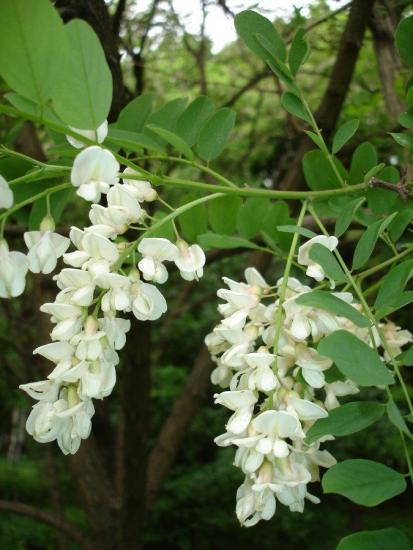
Long roots give the plant high wind resistance. The tree carries heavily polluted air and dust. Therefore, it grows well near highways, industrial enterprises and railways. Thanks to root nodules that bind atmospheric nitrogen, it can enrich the soil with this important element.
The presence of decorative forms make this tree attractive for garden designers. Growing a Robinia on your own is not difficult at all.
How to plant and grow Robinia false acacia
Robinia is well propagated by seeds or root offspring. Planting time is spring, since during autumn planting the plant will not have time to take root and grow enough root system. It is desirable to grow Robinia in good light and with protection from the wind from the north side.
Before planting, the seeds of this plant must be dipped in boiling water for 10 seconds and immediately dipped in ice water. This treatment will make the shell of the seeds softer, which will allow them to germinate quickly. Seeds should be sown immediately after treatment. They do this in pots in early March, and at the end of April they are planted in a greenhouse. As soon as the air temperature reaches + 18 + 20 degrees, the tree is transplanted to an open bed for growing.
Video on how to properly grow locust locust:
The landing site is dug up well and either wood ash, or old slaked lime, or dolomite flour is necessarily added. In heavy clay soil, it is desirable to add sand. If there are several seedlings, then the distance between them must be left at least 0.3 meters. In the first year, a seedling obtained by the seed method can reach a height of 1 m and even grow several side branches.
The following spring, before bud break, such a seedling is transplanted to a permanent place. If a root offspring is used, then planting is also carried out in the spring, before the buds open. Regardless of the method of obtaining a seedling, plant care is about the same.
Robinia Care
In the first year after planting a pseudoacacia seedling, it is important to systematically weed and carefully remove weeds. In addition, in order for the plant to have the opportunity to take root well, it must be watered regularly. One plant needs 1-2 buckets of water at least once a week. After watering, the ground under the bush is mulched with a mixture of soil and sand.
During the entire growing period, the near-stem circle under the tree must be kept clean. In addition, the whole season the plant needs complex mineral supplements. They need to be produced twice a month. In a temperate climate middle lane This plant has virtually no pests.

They threaten false acacia only in the southern regions with a warm climate. Separately, it should be said that Robinia not only grows rapidly, has a high decorative effect, it is also an excellent honey plant and plant.
Lush greenery in the garden is a dream, in the pursuit of which the plants are trying to intensively feed, care for them, but sometimes you have to wait for the result for many years. You can cheat time, and there are several options for this.
The first is to give preference to large-sized ones, and seedlings should not be bought the youngest. True, this is the main disadvantage of this method, since adult plants take root with difficulty, another drawback is the relatively high price.
A more acceptable option is to give preference to fast-growing shrubs and trees. True, it is better not to wait for active growth in the first year, the plants need to adapt and take root properly, but for the next season the garden will delight you.
During the season, fast-growing shrubs add up to 30 centimeters in height, and all 40 in width. Trees can boast impressive performance: up to 50 centimeters in height, and the crown diameter can become 80 centimeters larger.
Among the fast-growing trees and shrubs there are champions. Poplar, white locust, willow and birch are the fastest to gain height. In one season, they can grow more than one meter.
white acacia:
We recommend paying attention to the white acacia. In one season, it can add up to one meter in height and width! But such intensity is characteristic of a shrub only in the first 10-12 years of life, then the acacia grows more and more slowly, adding a maximum of 20 centimeters every year. But the white acacia will become a real decoration of your garden. Try planting several seedlings together at once, and as a result, a lush bouquet will appear on your site. Acacia is a sissy, so it is better to insure against possible frosts and give preference to zoned varieties.
Irga is distinguished by good growth among shrubs. 
Tatar maple, or Chernoklyon, or Necklen
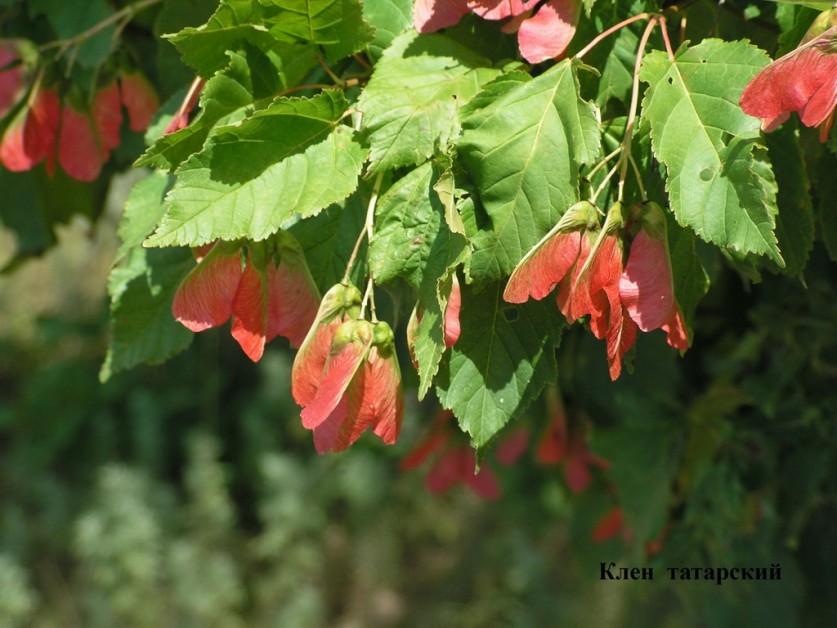
aralia high or manchurian 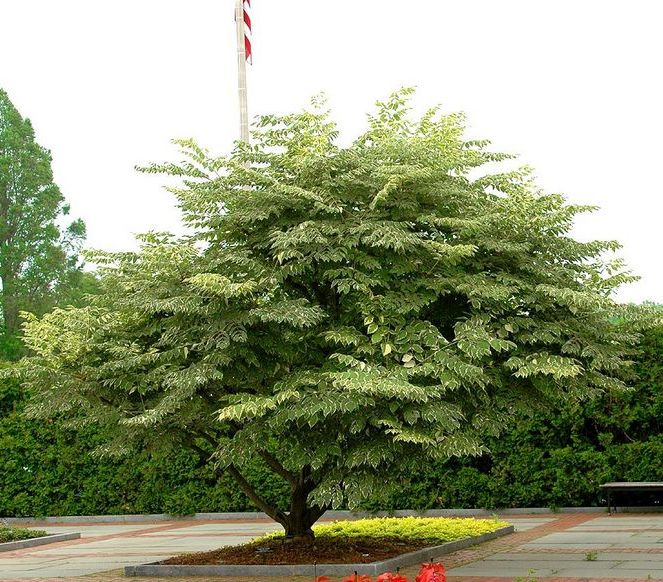
various types of lilacs 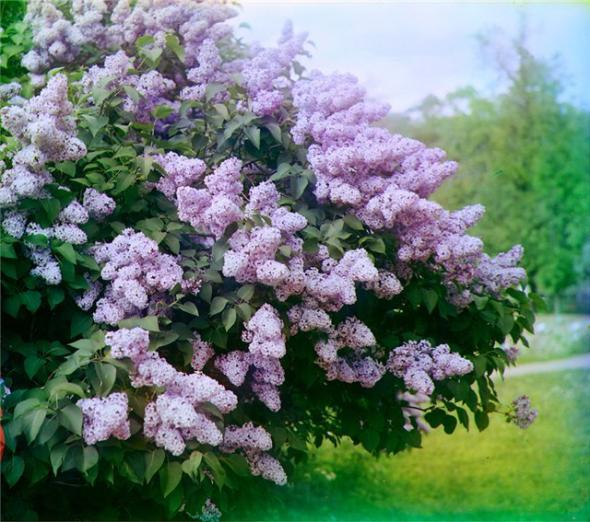
hawthorn 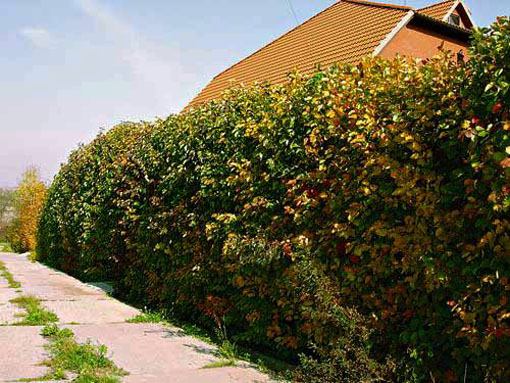
hawthorn fence 
viburnum vulgaris 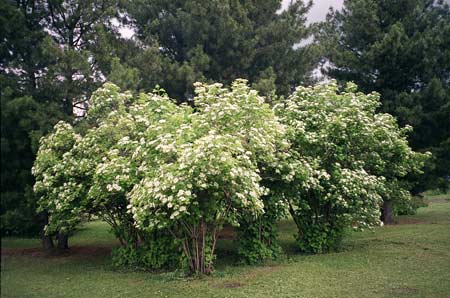
common hazel 
Japanese crimson, different, depending on the type 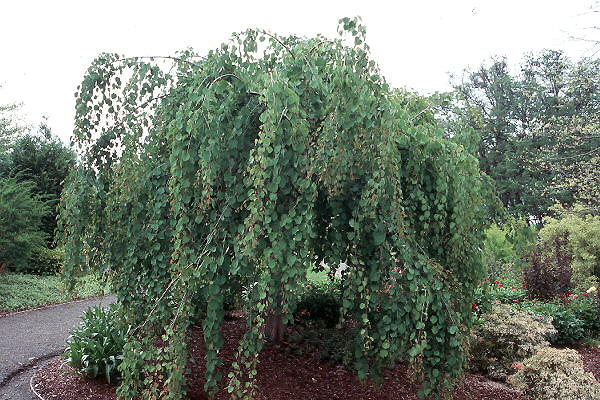
Getting thick bushes is not a problem; for this, it is enough to plant several seedlings at once in one hole. This procedure gives excellent results in relation to spirea and rose hips. And in the future, proper pruning later will preserve the shape of the shrubs.
Various types of conifers fit well into the design of the garden. Various types of juniper are popular:
common juniper 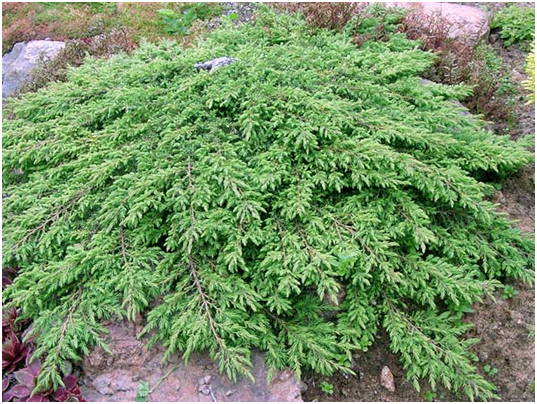
Fast-growing trees include bird cherry, drooping and fluffy birch, silver maple, red (northern) oak, larch, pine, spruce, poplar.
Willows look great: weeping, brittle, goat, white. These fluffy green balls are quickly overgrown with foliage and new shoots, while remaining just as light and lacy.
maple silver: 
red oak
weeping willow 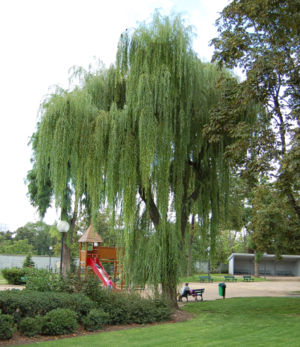
Willow brittle (spherical) or willow (Salix fragilis), spherical shape with a very dense crown. A tree 15 - 20 meters high with brittle branches, for which it received its specific name. Shoots are thick, shiny, olive-green. Large lanceolate leaves, up to 15 cm long, with a short drawn-out tip, dark green above, light green below, glandular-serrate along the edge. Grows fast, hardy. The age limit is 50 years.
Fast-growing trees and shrubs, growing every season by tens of centimeters and even meters, pretty soon create a full-fledged landscape on the site. True, it is better not to wait for active growth in the first year, the plants need to adapt and take root properly, but for the next season the garden will noticeably please you.
Among the fast-growing trees and shrubs there are champions. Poplar, white locust, willow, birch, silver maple and ash-leaved maple are the fastest to gain height. The landscaping of our parks is indispensable without them, and no doubt they will always find a worthy place in large private land holdings. Plots of modest size are more suitable for medium and undersized varieties of tree sprinters.
Often you have to consider the size of your garden. The smaller the garden, the fewer plants should be placed in it. The limited space of a small garden strictly regulates the choice between different plants and those that are suitable for a small garden. There should not be too many large specimens in this situation, one or two plants are enough to create focal points that organize the space of the garden.
Fast-growing trees also include bird cherry, red oak, larch, pine, and spruce. Willows look great: weeping, brittle, goat, white. These fluffy green balls are quickly overgrown with foliage and new shoots, while remaining just as light and lacy. Willow is photophilous, undemanding to the quality of the earth, but needs sufficient air and soil moisture. Various types of conifers fit well into the design of the garden. Junipers are popular.
White acacia will become a real decoration of your garden. In one season, it can add up to one meter in height and width, but such intensity is characteristic of a shrub only in the first years of life. In mid-summer, it attracts attention with an abundance of flowers and a sweet aroma. In autumn, flat bean pods appear on the branches - these "Christmas toys" decorate the plant in winter. If you plant several seedlings together at once, then a magnificent bouquet will appear on your site. Acacia is a sissy, it needs a sunny and windless warm place, so it is better to insure against possible frosts and give preference to zoned varieties.
Acacia yellow does not suffer from cold winds - this circumstance allows you to create ceremonial frontal hedges from specimens of this plant. Their indisputable advantage is a cheerful southern flavor. Both acacias attract butterflies, bees and birds like a magnet.
Irga, Tatar maple, Manchurian aralia, various types of lilacs, hawthorn, common viburnum, common hazel, Japanese scarlet are distinguished by good growth among shrubs. Black elderberry, mock orange grows very quickly. Spirea everything. And the common elderberry (it is also red) in two years can turn from crumbs into a lush bush and is cut "on time".
The red elderberry is notable for strong branching, large leaves and fruits that flare up in the crown with scarlet tassels in summer. The bush attracts birds, but it repels flies. The fact is that all its parts have an unpleasant odor. A person does not feel it, but insects feel and avoid it. Therefore, it is traditionally planted near compost heaps and other outbuildings, although the possibilities of its use are much wider. In the garden, for example around the summer dining room, there is hardly a more beautiful and functional green screen than red elderberry.
Alone or as a focal element in the company of birches, willows, viburnum, coniferous trees and black elderberry pleases the eye with bushes. This large shrub is interesting primarily for its crown shape and ornamental shades of light green leaves. For normal growth, this plant requires nutritious, loose, moist soil and light. It develops poorly in the shade, and the foliage loses its brightness.
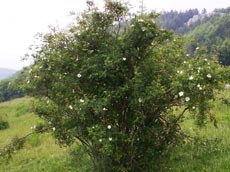 Decorative hedge from wild rose serves as a decoration of the site and at the same time its protection from prying eyes and unexpected guests. Getting thick bushes is not a problem; for this, it is enough to plant several seedlings at once in one hole. This procedure gives excellent results in relation to spirea and rose hips. And in the future, proper pruning will preserve the shape of the shrubs. These shrubs are not capricious, undemanding to soil conditions, drought-resistant and grow even on garden loam, they are distinguished by varietal diversity. Spiraea successfully takes root on ordinary garden soils, does not like stagnant water, tolerates frost well, prefers bright places.
Decorative hedge from wild rose serves as a decoration of the site and at the same time its protection from prying eyes and unexpected guests. Getting thick bushes is not a problem; for this, it is enough to plant several seedlings at once in one hole. This procedure gives excellent results in relation to spirea and rose hips. And in the future, proper pruning will preserve the shape of the shrubs. These shrubs are not capricious, undemanding to soil conditions, drought-resistant and grow even on garden loam, they are distinguished by varietal diversity. Spiraea successfully takes root on ordinary garden soils, does not like stagnant water, tolerates frost well, prefers bright places.
However, we should not forget that many shrubs have the ability to "spread" around the garden, suppressing other plants, and they practically do not change in height. These include tree hydrangea and fragrant raspberries. So if you want to quickly get a light and openwork garden, then it is better to refuse these shrubs. It is better to plant barberry, wild rose, honeysuckle or juniper.
In addition, the role of trees as dust and noise absorbers is important. Foliage actively captures dust and reduces the concentration of harmful gases, and these properties are manifested to different degrees in different species. Planting red elder, red oak, Canadian shadberry perform the most effective noise-protective functions. Interestingly, the sounds are not absorbed by the foliage of the trees. Hitting the trunk, sound waves are broken, heading down to the soil, in which they are absorbed. Spruce is considered the best guardian of silence. Even near the noisiest highway, you can live in peace if you protect your house next to green fir trees. And it would be nice to plant chestnuts nearby.
Poplars planted in a row resist heavy winds, thereby protecting the garden from freezing in winter. In the same way, you can isolate yourself from a dusty road. In summer, they not only give long shadows, but act as a kind of vacuum cleaners. Up to a ton of dust can settle on the leaves of an adult tree, which is washed off every time it rains. Speaking of poplars, one cannot but touch upon the problem of poplar fluff, which for many is a natural allergen, but among poplars there are varieties that do not give fluff at all, for example, white or silver poplar.
In order to cover the area with abundant vegetation, of course, fast-growing shrubs and trees are needed ...
The desire to green up and transform your garden or garden plot as soon as possible forces the owners of suburban real estate to take sometimes the most drastic measures. For example, many people want to have a shady spruce alley in the garden or have a birch tree on their own territory. However, as practice shows, the survival rate of young seedlings of these types of trees has a ratio; landscape design on which one has to go for additional tricks like landing http://www.soweren.ru/ozelenenie/posadka-krupnomernyh-derevev. To begin with, we will consider the reasons that push people to such measures, and then we will consider what can be advised to resolve this issue.
Don't want to wait long
Waiting for the moment when the accustomed seedling grows to the size of a quite decent tree can be delayed for 10-15 years. In this case, you will not know for sure what your plant will look like in the end. This is perhaps the most significant factor that guides people who dream of transforming their site as soon as possible.
How to start a transplant?
To take and transplant an unauthorized adult tree for one person is very difficult task. At the same time, unauthorized uprooting of a forest area can cost you problems with the law. Therefore, it would be most logical to contact the nearest forestry or a company that specializes in transplanting large-sized trees.
What is cheaper to plant?
Transplantation and sale of large-sized trees is already beginning to become quite a common practice in Russia. The limiting factor is the price of trees. In some cases, it can reach 100,000 rubles for 1 adult unit.
Planting trees of ordinary hardwoods is much cheaper: linden, maple, birch. Landscaping your site with spruces, pines or chestnuts will cost a little more. The highest cost is the transplantation of blue firs and cedars.
Winter is the best time to transplant
Oddly enough, but winter is the most favorable period of time for landing large-sized plants. All vegetative processes in the tree proceed at a minimum level and therefore the risk of injury to the root system and stem part is, in fact, the lowest. A frozen earth ball does not fall apart and tightly holds the roots of plants together. However, transplantation work must be carried out at a temperature not lower than -15 ° C.
The procedure for transplanting a large-sized tree
The size of the pit for winter planting must necessarily exceed the size of the earthen clod by approximately 1 meter in width and 0.25 m in height. At the bottom of the pit, a pillow is prepared from a layer of loose fertile soil and drainage: expanded clay, crushed stone or sand.
The tree is placed in the center of the hole and leveled. The voids are filled with defrosted fertile soil. To compact the soil, the winter planting site is thoroughly shed with water and some more earth is added.
The roots of a large-sized tree are insulated with a layer of peat, straw or crushed bark at a height of 0.2 meters. In order to avoid declining the crown of the tree, it is fixed by a number of lateral supports. From cold winds and spring sunburn, the tree is protected by hammered wooden shields.



